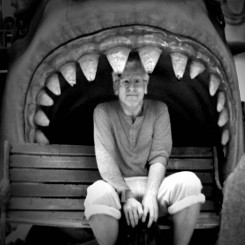The cryptically titled “Back Home with Baudelaire” takes home the Sovereign Asian Art Prize
The Hong Kong-based duo MAP Office was recently awarded the USD 30,000 Sovereign Asian Art Prize, for a limited edition print from their 2005 project “Back Home with Baudelaire,” where they followed some shipping containers from the moment they were loaded on a ship in Yantian Port, Shenzen, until the ship arrived in Victoria Harbor, Hong Kong.
It is a good decision, I humbly think: the selected image is of tantalizing beauty, gently drawing the viewer into itself, as only few depictions of vast spaces are capable of doing; it also says a lot about the world we live in, and the scale of the physical and conceptual waste we have covered it with.
That was my little review; but I didn’t sit down to write about any artist’s work as such — there are a million people who already do that way better than I would ever be able to, and they’re sharing all the little cash there is as reward for it. I just needed a prologue for my brief reflection on the preciousness of titles in contemporary art.
Titles are not born of the same root of art; they are born out of the very practical necessity of filing, categorizing and remembering artworks, so that people who want to impress other people in places where a certain culture has to be displayed may save time on long descriptions of something no one is genuinely interested in.
But then, just like most creatures that dwell on the corner of the eye, titles have grown freely and wildly in directions no one could have predicted. They can now be the key to interpret the complexity of the work they herald, what haiku poems are to Zen ideas of nature. They can be the mouthpiece of artists who hide behind the indecipherability of their monochrome canvases; some artists use them as shamanic formulas, and give a soul to their creations by naming them; occasionally they act as subtle agents of ambiguity, purveyors of confusion, and such is the case for the above-mentioned work.
In “Back Home with Baudelaire” I see an image of the South China Sea and I look at containers and cranes, almost feeling the sea breeze and the smell of iodine caressing my nostrils. Yet in my mind all considerations inspired by such poignant imagery have to compete with a frustrated expectation that still lingers within: where is the sitcom-like scene depicting the daily endeavors of the Baudelaire family and its struggles with the leading character’s poverty, deafness, addictions, and severe bad moods, the work I was expecting to see? Where is Montparnasse? Where is the absinth? And where is Baudelaire, the poet? Well, guess what, Baudelaire is now only the name of a ship, and I’ll have to come to terms with it.
I would have never been entertained by such mind-boggling juxtaposition; I would have never felt like writing about it, and you would have never read any of it, had it not been for that cheeky little rascal of a title that so well deserved to be credited.

